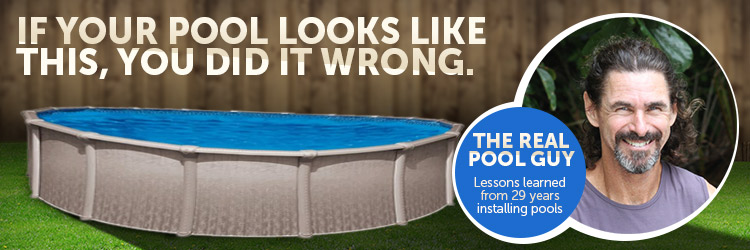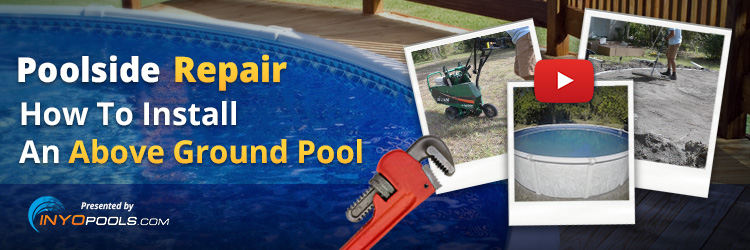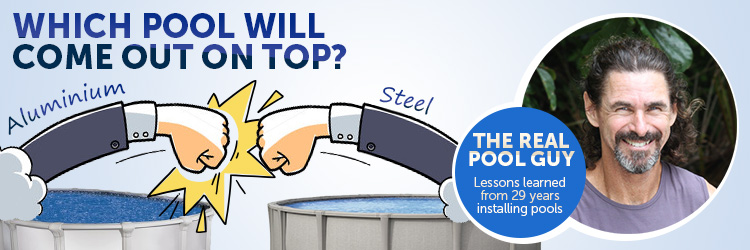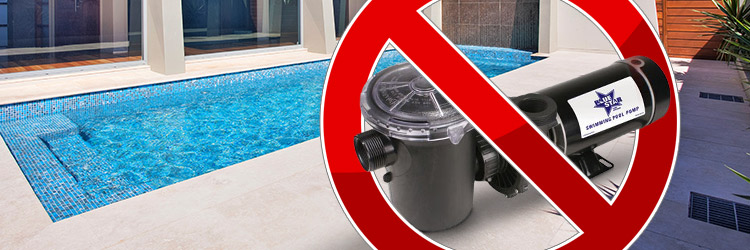I often say, “Above ground pools aren’t Swiss watches.” I usually say this to lower the expectations of pool owners for whom I’m about to install as some think just a little too highly of above grounds. Most of these pools are great and certainly worth the money. When installed correctly and maintained well, they will last many years providing the same enjoyment that other more expensive pools provide. However, they’re far from perfect.
Building above ground swimming pools takes a certain attitude. I am somewhat of a perfectionist so it took me some years before I finally got the concept. And that concept is having a “make-it-work” attitude. Above grounds usually come with poor and vague installation instructions. Just about everything with an above ground is adjustable and the few dimensions given in manuals are painfully inaccurate. Do-it-yourselfers often quickly abandon the numbers that come with their pool’s manual and they should because these numbers are almost always wrong. The numbers will be close, but not exact and we’re not playing horseshoes here. Or are we?
Above Ground Pools, Horseshoes, and Hand Grenades
There are different do-it-yourselfers in the world spanning from the “it-has-to-be-absolutely-perfect” all the way to the “if-it’s-standing-today-it’s-fine”. As a guy who has built thousands of above grounds and seen thousands that were built by novices, I’d say it’s best if neither of these extreme do-it-yourselfers attempt to build one. If you fall somewhere in the middle, then you should be OK. However, there are a couple of key things that have to be done right at least somewhat. Getting the pool’s shape right is one of those key things.
So what is meant by the pool’s shape? I mean you’ve bought a 24’ round pool. Won’t it be a 24’ circle of water? Well, it should, but may not be as an above ground pool can end up being more like the shape of an egg instead of a circle. As an example, a 24’ round pool can be 25’ across one way and 23’ across in the opposite direction and still stay up, have a liner free of wrinkles and hold water for years. It probably won’t last as long as a correctly shaped pool, but these wonky eggs can last longer than I often think. The same holds true for oval-shaped pools, but it’s more important for an oval-shaped pool to be its proper shape. Ovals are a pain to build regardless as they need to be squared as well. They lose their shape quickly when they aren’t correctly squared. In the end, the oval-shaped pool will be up and hold water, but only after a lot of swearing and cutting and beers.
Getting an above ground to its correct shape is important becauset it will make it last longer, but there’s a more important reason. When a pool is out of shape, nothing fits right during the installation. Everything will be a struggle as the wall may not line up, the top rails won’t go together right, the uprights may be tilted, and it will be more of a challenge getting the liner straight.

How Does a Pool Get Built Out of Shape?
Well, that’s easier to do than you think. Back in the eighties when I started building these things, most of our pools were built out of shape. We didn’t know any better so it didn’t matter much. We just swore more, bled a lot, and the pool looked off, but we still got paid because people didn’t know any different. There are two main ways a pool gets built out of shape. The first is the bottom track isn’t shaped right initially or at all. And the second way occurs when the pool wall comes together. The bottom tracks of above ground swimming pools have to be assembled by sliding them into connectors. Nothing is precise so there are adjustable gaps in the connectors and the track doesn’t sit perfectly in them either. The result is the track can easily become a shape other than what it is supposed to be.
The other way a pool gets built out of shape is not a result of a lack of building ability, but because the pool is not precise. The bottom track can be set perfectly in place being truly round and level and according to the dimensions of the pool. Then when the wall is rolled into this track and set in the groove, the wall can wind up longer or shorter than the track itself. When this happens, the track must be adjusted as the pool’s wall is in one continuous piece and cannot be shortened or lengthened. The result is the track gets moved inward or outward depending on if the wall was longer or shorter than the track. Are you following me here? If the track isn’t adjusted evenly, then the pool winds up not being shaped properly.
Frustration Meter at 10!
I’d like to add that these above ground pools aren’t built in a test room. Rolling out a long four-foot wide piece of sheet metal and standing it into a track is hard enough. When you consider that it’s hot and there’s dirt and the wind is blowing, it is downright challenging! Often it’s nothing short of a miracle that a couple of guys got that wall spun all the way around and that it is still standing. Then they discover that the wall is longer than the track. As the wall is in danger of blowing down and damaging itself and/or the track and since it cannot be cut, these guys are in a time-sensitive pickle. (This is one of those moments when DIY Bob remembers how expensive he thought my installation price was). The dangers of the wall blowing down and it not fitting induce panic and anger so these guys will then lengthen the bottom track in any way they can to get the wall to line up. And that is how the pool becomes egg-shaped.

So How Then Do I Make Sure My Pool Has the Correct Shape?
Get it a gym membership. Just kidding. Here are some tips to help get and keep your above ground pool in the right shape during installation:
Only Round Pools
- Assemble the bottom track where the pool is going to be placed.
- Measure across from each opposing connector plate and adjust in or out to get the desired diameter. Example: For a 24’ round pool, measure 24’ straight across each of the connectors. There are usually 16 connectors for that size so you are measuring across in eight different spots.
- Once you have the circle measured out evenly, secure the track somehow so it doesn’t move much during the installation of the wall.
- Level the track. Don’t move the track when leveling (pros level the track while it’s in place. If you are going to do it “YouTube style” then level your blocks somehow beforehand and good luck with that).
- Time to insert the pool’s wall. Secure the track so it won’t move much during the wall’s installation. How you ask? Use sticks or screwdrivers or something of the like. Make sure whatever you use doesn’t get in the way of installing the wall. You’ll know what that means soon enough.
- If the inserted ends of the wall line up, then you’re good. Bolt that bad boy together and move on.
6(a) If the wall is like a broke uncle and comes up short, shake the wall inward in several places around and pull it toward the gap at the wall ends. This will shorten the track. Line up the wall’s bolt holes from both ends and bolt the wall together.
6(b) If the wall winds up being too long, shake the wall outward and kick the wall out in several places. This will lengthen the track. As the track expands, the wall will move outward with it. Line up the moved wall’s holes and bolt together.
- If 6(a) or (b) occurred, the wall moved in or out, remeasure the track diameter from the inside in several spots and move the wall and track as needed to make it round again.
- Your pool is now round. Proceed with the building.
Oval-shaped pools are a lot trickier and since this blog post is already too long, I’ll have to explain about these some other time. Good luck.
If you have any questions on your above ground pool then we would be happy to help, feel free to give us a call at 1-877-372-6038 or email us at upload@inyopools.com If you liked this article then make sure to sign up for Blog and get our Free 128 Page Pool Care Guide.












I am installing a 15′ above ground. I am at the point of adding water and I started to install the top railing I have one upright that is leaning way in. Any pointers on how to correct this issue. Also my water is out of level about a 1 1/2 inches should I drain and relevel?